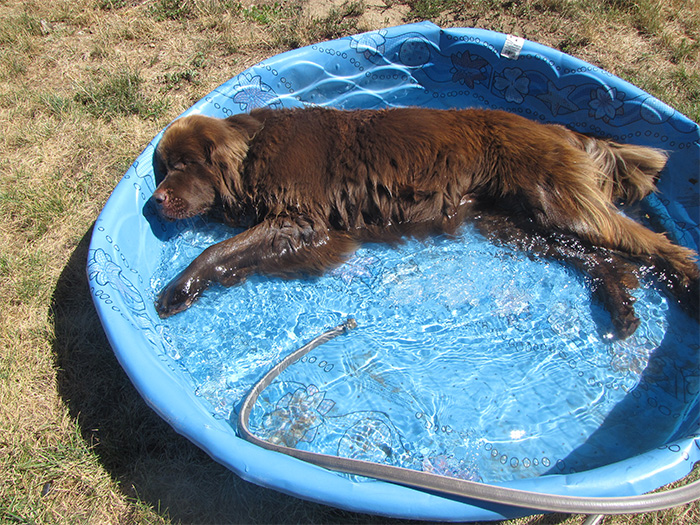Summer is arguably one of the best seasons for dogs and their owners. You can bask in the sun’s warm rays, play catch with the sunshine on your shoulders, and enjoy a wide range of activities in open spaces.
But before you play all morning under the sun, here are a few important things that you must know about staying cool in summer. Keep in mind that you want to enjoy a balance between spending quality time outdoors with your pet and ensuring its good health.
Heatstroke As the Main Concern
While sunburn is also a consequence of staying too long under the sun, the greatest concern is still heatstroke. Emphasis must be made that heatstroke among dogs can be fatal – in a Hebrew University study, 50% of dogs diagnosed with heatstroke will not survive.
Heatstroke refers to elevated body temperature, known as hyperthermia in scientific circles. In general, hyperthermia occurs when a dog’s temperature exceeds 103°F (39.4°C). When a dog’s body temperature reaches 106°F (41°C) without prior signs of illness, the culprit will likely be excessive environmental heat, such as exposure to the hot sun for prolonged periods.
Aside from prolonged exposure to the sun during the doggone days of summer, dogs can also suffer from heatstroke due to the following causes:
- Leaving a dog inside a car with insufficient ventilation (i.e., heatstroke sets in within minutes)
- Leaving a dog in a yard without convenient access to water and shade on a hot day
- Exposure to a hair dryer for a prolonged period of time
- Excessive exercise or vigorous physical activity during hot days
Emphasis must be made, too, that dogs do not possess the ability to sweat to control body temperature. This is because canines only have a limited number of sweat glands in their footpads, thus, their primary way of body temperature regulation is by panting. When dogs are confined to rooms with insufficient ventilation on a hot day, their risk for heatstroke also increases.
The following dogs are also at high risk for heatstroke even when other dogs can cope well:
- Breeds with restricted airways, such as flat-faced dogs like boxers, pugs, and bulldogs, can suffer from heatstroke even when the environmental temperature is only moderately elevated.
- Dogs with muzzles because their ability to pant is severely restricted.
- Dogs with infections characterized by fever, or severe muscle spasms, or seizures (i.e., the last two can elevate body temperature because of the increased muscular activity.
Just remember that when your dog appears to be struggling with the heat, then it probably is struggling. You have to adopt simple yet effective measures to ensure that it will not fall prey to heatstroke on your watch. You must, however, inform your veterinarian about the matter just to be on the safe side.
Measures to Counteract Heatstroke
Heatstroke, fortunately, can be avoided by following a few simple measures. You can also keep a handy stock of accessories useful in heatstroke prevention bought from Petsmart or Petco; a doggy pool, for example, will do.
Follow your dog’s lead.
Your pet will follow its instincts when it gets too hot and your job is to look for the signs. Your pet may exhibit signs of fatigue, such as unwillingness to follow you on the hike in search instead for shady spots. You should follow its lead, carry it, and go back home for appropriate preventive measures.
Follow your instincts.
While canines and humans have different natural ways of coping with the heat – humans by sweating, dogs by panting – you have to remember that when you cannot sit outside comfortably for even a short period, then your dog cannot do so either. Get your pet inside a cool house with sufficient ventilation immediately.
No haircuts for your dog.
While humans may have their hair cut during the summer to cool off, it is not applicable for dogs even in the name of good grooming. Your dog’s coat acts as a buffer against the heat, which helps it regulate its body temperature along with panting. Giving your dog a haircut, more so shaving its hair, will only do more harm than good.
No ice either.
Packing ice packs around your dog’s body will also endanger its life – the cold causes the blood vessels to constrict, which means the body cannot remove excess heat. Instead, just douse your dog with room temperature water and place it in front of a cooling fan.
Give your dog plenty of fresh, cool water to drink.
Sufficient hydration is a must for dogs during hot days. If your dog must be outside, then place your dog’s water dish in a shady location and change its contents frequently. Better yet, install a watering system hooked up to faucet that your dog can trigger when it gets too hot.
And when you suspect that your dog may have hypothermia, don’t hesitate in bringing it to the vet’s clinic for proper medical attention.


